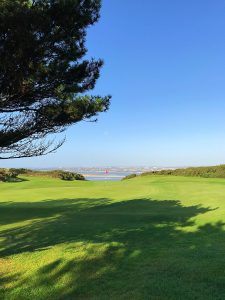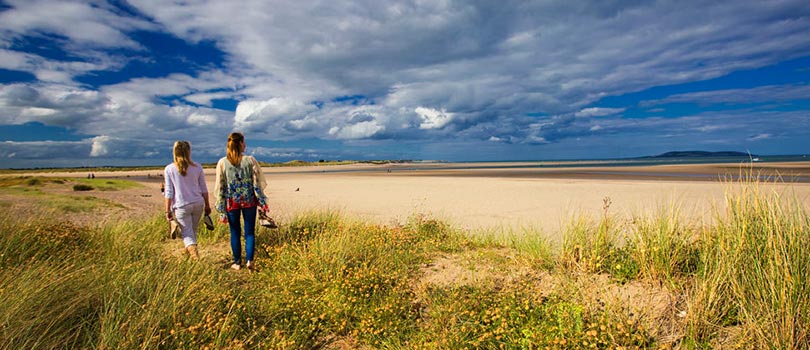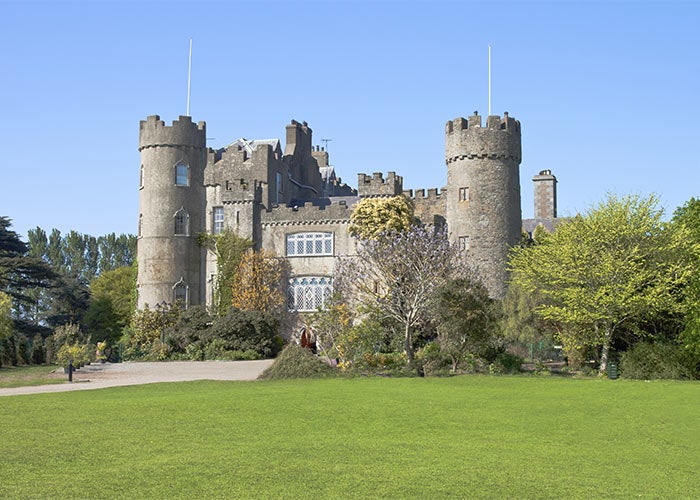Places to See & Things to Do

Welcome – The Village of Howth is a vibrant, colourful and beautiful village set above the well known Howth Harbour on the North East of the Howth Sutton peninsula, where there are many historical and scenic areas worth exploring. Whether you live in the vicinity or just visit from time to time, you will always find a warm welcome awaiting you from locals and the many business people who inhabit this wonderfully scenic area. As you approach the peninsula from Sutton Cross you will face a choice of routes to take you into Howth. If you turn right at the Marine Hotel and take Geenfield Road up towards Howth Summit you’ll pass the entrance to Howth Golf Club on the left until you eventually arrive at the Summit. From there you can enjoy a truly spectacular and panoramic view of Dublin Bay that surely rivals any scene any other capital city in the world can offer. Visitors to Howth Golf Club can savour the same views as they tee up on the 14th, 15th and 16th holes.
Howth peninsula is a very scenic and beautiful coastal area only 7 miles from Dublin Airport and 9 miles from Dublin City Centre. The Peninsula forms part of Fingal, a large area in North County Dublin. Public transport to Howth is available via Train and Bus and both are scheduled at regular intervals throughout the day. Further information on bus schedules can be got from Dublin Bus at www.dublinbus.ie or for train information visit www.irishrail.ie
Howth offers many activities by which you can entertain yourself and your companions, from wonderful hill walks with enthralling views, to boating trips, angling, many Bars and fine Restaurants (with fresh fish daily! ), to a weekly market situated on the West Pier of Howth Harbour. For generations Dubliners have enjoyed the sanctuary of the Howth Sutton peninsula which also attracts day trippers from all over Ireland, making it one of the capital city’s best loved destinations. Howth people are justifiably proud of their old fishing village where fisherman operate a full fleet of Trawlers from the Harbour. Nowadays visitors can been entertained by the presence of 10-20 Seals who have taken up residence in the Harbour and can be seen from the West Pier. The Seals have become a huge attraction for visitors and locals alike and a great many people can be seen strolling in the area during the summer months especially.
Howth’s History is broad and varied – legend has it that Howth was once home to Croimthain, whose Castle (In Irish: Dun Croimthain) lends its name to the road that passes by, now known as Dungriffin Road. When the Vikings raided Ireland a major battle took place at an area called The Bloody Stream, where a Bar & Restaurant of the same name now operates, is situated immediately under Howth Dart station at the entrance to Howth Harbour. There are plenty of old ruins and buildings to be explored too including the 12th century Abbey and graveyard in the heart of the village.
The Early Settlers in Howth
It is believd that the first people to make Howth their home did so some 5,000 years ago. It is thought they settled mostly on the South end of the island, as that would have afforded them shelter from the north winds and rain as they mainly hunted and fished the woods and waters around the peninsula. There have been some artefacts found in Balscadden Bay leading to the Harbour’s East Pier that indicate this was originally the site of a fishing village.
Howth Castle
Howth Castle lies very close to the village of Howth, but not within it. It is the ancestral Home of the family linage known as the Earl of Howth, and the estate of Deerpark, which surrounds the Castle. Today the estate is still run by the ancestral heirs of the baronage, the Gaisford St. Lawrence family, of whom Gaisford St. Lawrence is the President of Howth Golf Club.
Howth Castle is surrounded by many legends, none more interesting than that which relates to the visit of the Pirate Grace O’Malley. The legend has it, that in 1576, Grace O’Malley (Known as the Sea Queen of Connacht) made an attempt to visit the then 8th Baron of Howth, but when she arrived at the gates of the Castle, they were closed to her and she was informed that Family were at dinner.
Not taking too kindly to being refused entry to see the Baron as he was dining, legend has it that Grace O’Malley abducted the grandson of the Baron, and as part of the ransom and bargain for his safe return, Grace O’Malley made the Baron promise that in the future, the gates of the castle would at all stages remain open to any unexpected visitors and that a place at the dining table would always be set for unexpected guests. The descendants of the 8th Baron of Howth still maintain this promise, and to this day at Howth Castle there is a place setting available for any unexpected guests.
Transport Museum and the Howth Tram
The National Transport Museum is also located within the grounds of Howth Castle.
The Museum house’s some 170 vehicles, the earliest dates back to 1883 and the newest to 1984. The Museum was originally started as a result of a Society that was formed in an effort to preserve 3 Trams. The last open top Trams to operate in the world was on 31st May 1959 on the Howth Tramline. More recently due to modern developments in transport the tram has returned to the street of Dublin – now known as Luas. But we still miss the novelty of open top trams in Howth!
The original tramline has since been converted to a walkway that links Howth Village with the Summit. It stretches through a deep gorge at the start known locally as Kruger’s Cutting after the Boer war hero, famous at that time for the routes construction. ( Howth now boasts a Bar of the same name situated at the commencement of the walkway)
Light House on Howth Peninsula:
The first Lighthouse was built around 1667 by Sir Robert Reading. This original building was according to historians a small cottage that bore only a coal fired beacon. Its original position was high on the slopes of Howth and, at times the fog blocked the warning intended. As a result of this, in 1811 an order was given to relocate the Lighthouse south to Dungriffin and these works were completed on St.Patrick’s Day, 17th March 1814.
Ireland’s Eye
Hill Walks
Howth is a place of great beauty with some breathtaking views over Dublin bay and the village of Howth itself. One of the best ways to enjoy and experience these views, (apart from playing golf at Howth Golf Club!), is to take a walk along one of the many coastal pathways. The paths lead all the way around Howth and walks can be as short as 1 hour for the casual sightseer or up to 3 hrs for the more avid walker.
 Lambay and Ireland’s Eye Island’s.
Lambay and Ireland’s Eye Island’s.
Lambay Island and the island known as Irelands Eye are within touching distance of Howth Golf Club, or so it seems on a clear day from the 1st fairway.
Both islands have a long history, with Lambay Island being credited with giving Howth its name. The name Howth comes from the Norse word, Hoved, meaning Head, and history has it that Lambay is one of the first occupations of the Vikings in 795 AD.
Irelands Eye was the site of a Monastic Settlement in or around the 7th century. A settlement apparently called “Cill-mac-Nessan” was placed on the Island by the sons of Nessan, who himself was a prince of the House of Leinster. This partnership is thought to have produced a book of Gospel called “The Garland of Leinster” a book containing four gospels and its thought that it may have been written on the Island itself. To this day St. Nessans’ Church can still be seen on the Island from the mainland if viewed to the north from Howth Harbour. In the 8th century the settlement was attacked by English pirates and later the Vikings.

MALAHIDE – 10 minutes from Howth Golf Club
1 DayItinerary
Suggestions for your 1 day in Malahide:
Malahide Castle & Gardens
One of Ireland’s premier tourist attractions, set on 260 acres, this magnificent and historic 12th century castle had been home to the Talbot family for over 800 years. The Castle and Gardens were reopened in 2012 with a state of art Visitor Centre and newly accessible Gardens which feature many rare species and are a must for all horticultural enthusiasts. Click here for their website
After your visit to the castle, time permitting why not indulge yourself with something to eat and drink in our heritage village. The numerous cafes, restaurants and bars in the village can cater for any and all tastes. Seafood, is naturally, a speciality. If you still have some time to spend in the area why not work off your meal with a coastal walk towards Portmarnock as far as Malahide beach, the sea air and stunning scenery is the perfect way to round off a day in Malahide.
5 Day Itinerary
Experience the beauty of Fingal with a five day stay. The visitor can get deeper into all that this region has to offer.
Day 1
Settling in
Arriving in Malahide, take time to get settled in. Sample the unique atmosphere of the village. A browse around the many shops, restaurants and bars is a great introduction to this heritage village. Savour the delightful dilemma of where to eat on your first day.
Day 2
Castle
A visit to the renowned Malahide Castle and gardens is a must. Set in 260 acres, the Castle and Gardens is one of Irelands premier tourist attractions. The 12th century castle was home to the Talbot family for more than 800 years. The gardens feature many rare species of flora and fauna and are a must for all horticultural experts and amateurs alike. Extensive walks, a children’s playground and outdoor exercise equipment can pass several hours in and around the castle.
A visit to one of Malahide’s famous pubs for a drink and music session or just good conversation with the locals is an ideal way to round off the second day of your stay in Malahide.
Day 3
Shopping and stroll
A leisurely stroll around the many shops and attractions in Malahide is a good way to continue your visit. The village which retains many of its original architectural features is home to a wide variety of shops, featuring clothes, food and bric a brac. A morning spent browsing and shopping can be rounded off with lunch in one of the many restaurants and bars that serve a wide range of meals from simple sandwiches to gourmet fare.
Time for a walk after all that shopping. A trip along the coastal path out past the tennis club provides brisk coastal air and stunning views of Lambay island. For visitors who fancy a more energetic afternoon walk the full length of the coastal path between Malahide and Portmarnock is a must. The walk features miles of beautifully rugged coastline and breathtaking views of Lambay Island, the Howth peninsula and Dublin Bay. Visitors can relax on the beach, go for a swim or take in the sea air and beautiful scenery on the coastal walk.
Some visitors might choose to travel further afield, to Howth for a walk, and some refreshment. The more nimble-footed might choose to take a cliff walk in this seaside village. Suggested routes to suit most abilities are available. All the routes provide views of the Bailey lighthouse and out across Dublin bay. a round of golf at Howth Golf Club.
Dinner and a drink in one of Howth’s famous seafood restaurants will finish off the day in style.
Day 4
City Centre
A longer stay will allow the visitor to visit Dublin city centre and one of the many tourist attractions in Ireland’s Capital. Public transport is the best way to make the journey into the centre. The DART or bus trip takes around 40 minutes. A day spent shopping or visiting the many historic attractions might be finished off with a meal in the city centre before taking the train or bus back to Malahide. Transport services run until approximately 23:00. Alternatively, if the sight-seeing has taken its toll an early evening return to Malahide for food in one of the many eating venues can provide a relaxing end to day four.
Day 5
Fingal explored
A visit to one of the other Fingal towns or villages is a great way to spend day five in the area. Howth, Rush, Skerries or Balbriggan are all within 30 mins from Malahide by train or bus. The sea air and historic sites dotted around the Fingal coastline will give the visitor a taste of what is on offer for the compulsory return visit to the area. Newbridge House and demesne in Donabate, or Ardgillan Castle in Balrothery will provide a different insight into Fingal’s many big houses and castles. Alternatively, a short hop by bus, or walk for the more energetic visitor, from Malahide will bring you to Swords. This bustling county town offers History and retail in equal measure. A tour of Swords castle will unveil some of the rich history of the area, before spending the rest of the day shopping. Malahide is only 3 kilometres away so the visitor can choose to finish the day in Swords with many food options or return to Malahide where, by now you will be treated as a regular in the bars and restaurants.




